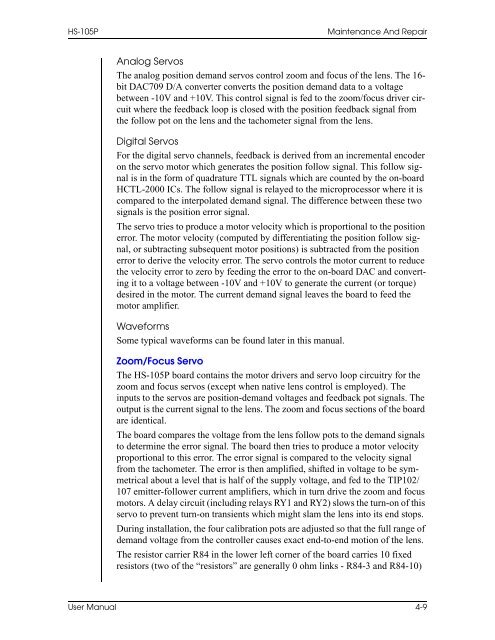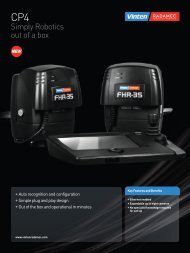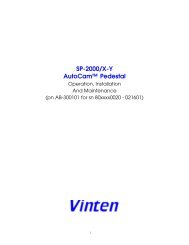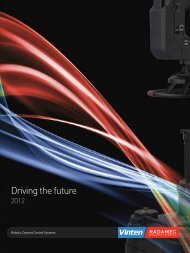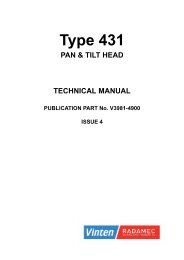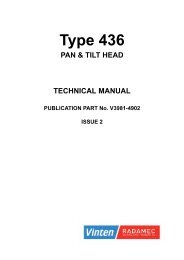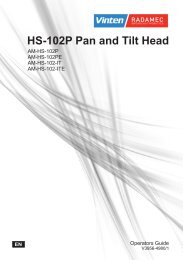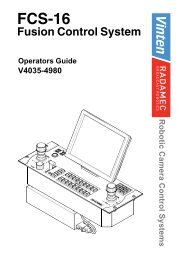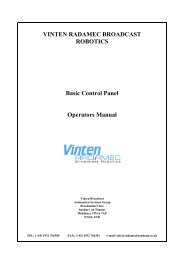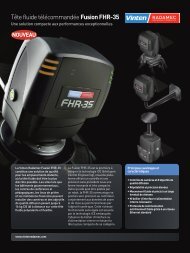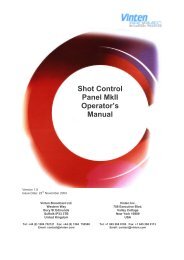HS-105P, PE. SA AutoCam™ Pan & Tilt Head - Vinten Radamec
HS-105P, PE. SA AutoCam™ Pan & Tilt Head - Vinten Radamec
HS-105P, PE. SA AutoCam™ Pan & Tilt Head - Vinten Radamec
Create successful ePaper yourself
Turn your PDF publications into a flip-book with our unique Google optimized e-Paper software.
<strong>HS</strong>-<strong>105P</strong> Maintenance And Repair<br />
Analog Servos<br />
The analog position demand servos control zoom and focus of the lens. The 16bit<br />
DAC709 D/A converter converts the position demand data to a voltage<br />
between -10V and +10V. This control signal is fed to the zoom/focus driver circuit<br />
where the feedback loop is closed with the position feedback signal from<br />
the follow pot on the lens and the tachometer signal from the lens.<br />
Digital Servos<br />
For the digital servo channels, feedback is derived from an incremental encoder<br />
on the servo motor which generates the position follow signal. This follow signal<br />
is in the form of quadrature TTL signals which are counted by the on-board<br />
HCTL-2000 ICs. The follow signal is relayed to the microprocessor where it is<br />
compared to the interpolated demand signal. The difference between these two<br />
signals is the position error signal.<br />
The servo tries to produce a motor velocity which is proportional to the position<br />
error. The motor velocity (computed by differentiating the position follow signal,<br />
or subtracting subsequent motor positions) is subtracted from the position<br />
error to derive the velocity error. The servo controls the motor current to reduce<br />
the velocity error to zero by feeding the error to the on-board DAC and converting<br />
it to a voltage between -10V and +10V to generate the current (or torque)<br />
desired in the motor. The current demand signal leaves the board to feed the<br />
motor amplifier.<br />
Waveforms<br />
Some typical waveforms can be found later in this manual.<br />
Zoom/Focus Servo<br />
The <strong>HS</strong>-<strong>105P</strong> board contains the motor drivers and servo loop circuitry for the<br />
zoom and focus servos (except when native lens control is employed). The<br />
inputs to the servos are position-demand voltages and feedback pot signals. The<br />
output is the current signal to the lens. The zoom and focus sections of the board<br />
are identical.<br />
The board compares the voltage from the lens follow pots to the demand signals<br />
to determine the error signal. The board then tries to produce a motor velocity<br />
proportional to this error. The error signal is compared to the velocity signal<br />
from the tachometer. The error is then amplified, shifted in voltage to be symmetrical<br />
about a level that is half of the supply voltage, and fed to the TIP102/<br />
107 emitter-follower current amplifiers, which in turn drive the zoom and focus<br />
motors. A delay circuit (including relays RY1 and RY2) slows the turn-on of this<br />
servo to prevent turn-on transients which might slam the lens into its end stops.<br />
During installation, the four calibration pots are adjusted so that the full range of<br />
demand voltage from the controller causes exact end-to-end motion of the lens.<br />
The resistor carrier R84 in the lower left corner of the board carries 10 fixed<br />
resistors (two of the “resistors” are generally 0 ohm links - R84-3 and R84-10)<br />
User Manual 4-9


